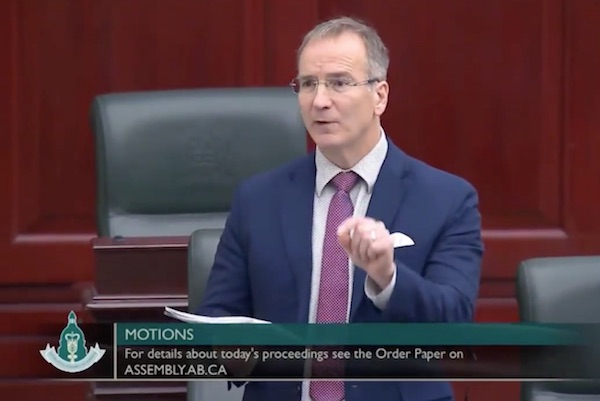Community
RED DEER’S OPPORTUNITY FOR A NEW AND BETTER APPROACH FOR HOMELESSNESS AND ADDICTIONS

Article submitted by Red Deer South MLA Jason Stephan
Dear Friends,
There is a profound need in our community to have fairness for all – supporting our neighbors suffering under addictions, while respecting businesses and individuals working and families raising children in our City. This is a longer article; the issues at stake deserve nothing less.
A. Addiction Recovery Community
Last month, I joined my friends Minister LaGrange, our Mayor, the Infrastructure Minister and the Associate Minister of Mental Health and Addictions to break ground for an “Addiction Recovery Community” for Red Deer. Ours is the first under construction! This community will be located north of the City, off Highway 2A.
Earlier this year I visited the Thorpe Recovery Centre, west of Lloydminster, which also operates under this model. This is what I observed. No drugs. A place of safety and refuge, where those seeking recovery live for months making positive connections. Men and women from all walks of life supporting and encouraging each other in their individual paths towards recovery.
I attended a meeting with Thorpe residents. There was an honesty and vulnerability in those discussions that was both courageous and inspiring. Taking individual responsibility for one’s recovery while seeking to love and support others to do the same is heroic.
Red Deer is a special place; there are many families, churches, and organizations in our community that have desires to love and support our neighbours in their individual paths to recovery. This recovery community will increase opportunities to do so.
Addiction is a challenge of human nature. Success in this complex matter must begin with the end in mind: supporting and loving our neighbours to become free from addictions.
Please consider this question, if someone you loved was suffering under a drug addiction would you take them to a drug consumption site? No! You would love and support them, not in living in their addictions, but becoming free of them. This will become easier with our recovery community. Participants in recovery will experience transformative miracles in their lives, blessing themselves, healing their families and our communities. This is very exciting!
B. Overdose Prevention Site (OPS)
Red Deer did not ask for an OPS; the NDP imposed it on Red Deer, ignoring the concerns of civic leaders, local businesses, and families.
As a private citizen, prior to seeking to serve as an MLA, I attended packed town hall meetings at City Hall. The vast majority of townhall participants did not want an OPS in Red Deer. But this was not an option provided by NDP/AHS to civic leaders – their input was limited to not “if” there was an OPS, but “where”.
With input from citizens, City council said the OPS should be at the Hospital. But this choice was rejected on the basis that it was not safe! It appears that the NDP did not have the same concerns for families and businesses elsewhere.
The OPS has now been in our community for years and its impacts are evident for all to see. Let’s speak plainly and honesty. The OPS has become an attraction for individuals who are not from Red Deer, to come to our City, to live in drug addictions. Because of this drug consumption site, there are more, not less, suffering under addictions in Red Deer.
There is an exodus of businesses from our downtown. There is too much stealing, too much vandalizing, too much uncertainty for local businesses, their employees, their customers. The City has invested so much of our tax dollars seeking to revitalize our downtown. So much of this effort is being undermined by the OPS. Regardless of good intentions, the truth is that the OPS has facilitated a growing lawlessness, including embedding and emboldening criminal elements, which either abuse the OPS or prey on those living in addictions, some of whom support addiction lifestyles through stealing or robbing businesses and families in our community.
A prioritization on “harm reduction”, such as the OPS, has caused great collateral “harm expansion” to businesses and individuals in our community seeking to live their lives, working, and raising their families. One does not have to take a position on the substantive merits of an OPS to reach a good faith conclusion that not every community should be required to have an OPS. Red Deer is not a large city; we are becoming overwhelmed. The published report of the panel conducting the supervised consumption services review, listening to our community businesses and families, conclude that that the overall social and economic impact of Red Deer’s OPS is negative.
We have a new, elected city council with different experiences and competencies that can add much value and insight. If this Council wishes to reverse the NDP forcing an OPS on Red Deer, they need to speak unambiguously on this important matter. Such a position supports a substantial majority of individuals, families, and businesses in our community, and I sustain them.
Together we have an opportunity to support a fundamental course correction; focusing on healing and recovering, while providing opportunities for those who want to continue to use OPS services to transition to other communities that wish to continue with these services.
C. Integrated Shelter Service
Budget 2020 announced about $7 million for an integrated shelter service for Red Deer.
A new shelter service is an opportunity for a newer, better culture. Our shelter should be a place of hope where individuals receive support and opportunities to work towards moving out of shelter and towards self-reliance, including, as applicable, with invitations to access our new addiction recovery community. There are individuals working in our existing shelters who are seeking to love and
support their neighbors using shelter services. Let’s support their efforts to do even better!
But this is not all, this new shelter needs to be an accountable service, not only to the individuals it serves, but also as a good neighbour to families and businesses in our community. Many families and businesses in our community are very concerned with growing property and persons crimes, needle debris, and shelter camps and garbage in public spaces caused, in many cases, by adult users of current shelter services.
Properly implemented, an integrated shelter service is a great opportunity, to make an imperative course correction, better serving our homeless adult population, while repairing a frayed social fabric and distrust in our community; improperly implemented, this shelter will entrench an unacceptable status quo and exacerbate growing frustration in our community.
Minister LaGrange and I have advocated for our City Council to have input in shelter decisions with significant impacts to a local community. They are choosing the location of the new shelter. I am grateful our Council is doing so – their insights and perspectives as our local leaders should be valued and respected. Nevertheless, the “how” of the shelter, is at least as important as the “where” of
the shelter. These resources provide us with opportunities to improve the “how” of shelter services in our City. Here are some opportunities for consideration:
1. No Shelter Services in Residential Neighborhoods
Mustard Seed is a great organization supported by generous volunteers and employees in our community. Out of its Riverside Meadows location, Mustard Seed provides many services which bless individuals and families in our community. But homeless shelters do not work well in residential neighbourhoods.
There is an opportunity with this Provincial funding to support migrating Mustard Seed’s shelter services out of Riverside Meadows to a non-residential location, while continuing to support our Mustard Seed in maintaining its other, non-shelter services in its current location, such as providing lunches to children in schools.
2. Consolidate Homeless Meal Services into One Location
Red Deer has three organizations providing homeless meal services: Mustard Seed, Red Deer Soup Kitchen and Potters Hands. These are great volunteer service organizations. Our community has so many individuals and families with compassion to serve our neighbours. Given our smaller downtown, this Provincial funding provides an opportunity to consolidate our meal services into one location while supporting each of these organizations to continue serving our neighbours.
Consolidation will allow for better oversight of litter and social issues to neighbouring properties and businesses. Working together these organizations can have opportunities to combine their individual resources together providing even better meal services, while retaining their organizational autonomy and control to continue to uniquely serve our neighbours in love.
3. Locate All Shelter Services Proximate to Each other
Currently dry shelter services are principally provided by the Mustard Seed; wet shelter services are principally provided by Safe Harbour. Better shelter services leverage off respective competencies and strengths of different community organizations, including opportunities for many great families and individuals in our community to volunteer and serve!
Our city is small, let’s situate all dry shelter and wet shelter services proximate to each other to reduce issues for wider City families and businesses, while supporting the organizational autonomy of service providers respecting their organizational culture, their strengths, and competencies.
4. A Culture of Hope in Shelter Services
An overarching shelter culture which encourages and supports positive steps towards self-reliance for adult shelter users, including for addiction recovery as applicable, engaging civil society volunteers and our service organizations, and local businesses, will result in shelter services with a culture of hope.
5. Opportunity for our City to own our Shelter Infrastructure
It is important to recognize that the ownership of our new shelter infrastructure and the operation of shelter services in that location can be separated. While I respect that others may have different perspectives, there will be great public benefit, even protection, if the City considers owning this new shelter infrastructure. Why? Because as shelter services must be provided in a “good neighbour” manner, there needs to be an ability for the City to not only ask an operator to be better, but even seek replacement of the operator if they fail to do so.
If a shelter operator owns shelter infrastructure, while the Province can, as a last resort, end operational funding to the operator, the Province would be then compelled to not only seek an alternate operator, but also alternate infrastructure to provide shelter services. That requirement increases the cost of changing a bad operator higher, and as a result, harder. Therefore, if shelter infrastructure ownership is with the City, the ability to require accountability from shelter operators increases.
Separating ownership from shelter operations recognizes that shelter boards and management change over time. Good operators today may be less good tomorrow. If shelter ownership is separate from shelter operations, there is more protection over time against a risk of a shelter service provider beginning to act with less care for the collateral consequences of their actions to businesses and families in the community.
The Province does not own shelters, but we do not want them to do so. A future provincial government may transfer ownership to a shelter service provider, contrary to the interests of a local community. The City, which better understands our local needs and circumstances, is a better person to be entrusted with this critical public infrastructure.
D. The pieces are there; let’s put them properly together!
Doing things in the right way, may require us to do things differently, and better, from past approaches. With new strategic investments from our Provincial Government, we have a unique opportunity to make transformative course corrections which will bless businesses, families, and individuals in our community over the long term!
Community
SPARC Red Deer – Caring Adult Nominations open now!

Red Deer community let’s give a round of applause to the incredible adults shaping the future of our kids. Whether they’re a coach, neighbour, teacher, mentor, instructor, or someone special, we want to know about them!
Tell us the inspiring story of how your nominee is helping kids grow up great. We will honour the first 100 local nominees for their outstanding contributions to youth development. It’s time to highlight those who consistently go above and beyond!
To nominate, visit Events (sparcreddeer.ca)

Addictions
‘Harm Reduction’ is killing B.C.’s addicts. There’s got to be a better way

From the Frontier Centre for Public Policy
B.C. recently decriminalized the possession of small amounts of illicit drugs. The resulting explosion of addicts using drugs in public spaces, including parks and playgrounds, recently led the province’s NDP government to attempt to backtrack on this policy
Fuelled by the deadly manufactured opioid fentanyl, Canada’s national drug overdose rate stood at 19.3 people per 100,000 in 2022, a shockingly high number when compared to the European Union’s rate of just 1.8. But national statistics hide considerable geographic variation. British Columbia and Alberta together account for only a quarter of Canada’s population yet nearly half of all opioid deaths. B.C.’s 2022 death rate of 45.2/100,000 is more than double the national average, with Alberta close behind at 33.3/100,00.
In response to the drug crisis, Canada’s two western-most provinces have taken markedly divergent approaches, and in doing so have created a natural experiment with national implications.
B.C. has emphasized harm reduction, which seeks to eliminate the damaging effects of illicit drugs without actually removing them from the equation. The strategy focuses on creating access to clean drugs and includes such measures as “safe” injection sites, needle exchange programs, crack-pipe giveaways and even drug-dispensing vending machines. The approach goes so far as to distribute drugs like heroin and cocaine free of charge in the hope addicts will no longer be tempted by potentially tainted street drugs and may eventually seek help.
But safe-supply policies create many unexpected consequences. A National Post investigation found, for example, that government-supplied hydromorphone pills handed out to addicts in Vancouver are often re-sold on the street to other addicts. The sellers then use the money to purchase a street drug that provides a better high — namely, fentanyl.
Doubling down on safe supply, B.C. recently decriminalized the possession of small amounts of illicit drugs. The resulting explosion of addicts using drugs in public spaces, including parks and playgrounds, recently led the province’s NDP government to attempt to backtrack on this policy — though for now that effort has been stymied by the courts.
According to Vancouver city councillor Brian Montague, “The stats tell us that harm reduction isn’t working.” In an interview, he calls decriminalization “a disaster” and proposes a policy shift that recognizes the connection between mental illness and addiction. The province, he says, needs “massive numbers of beds in treatment facilities that deal with both addictions and long-term mental health problems (plus) access to free counselling and housing.”
In fact, Montague’s wish is coming true — one province east, in Alberta. Since the United Conservative Party was elected in 2019, Alberta has been transforming its drug addiction policy away from harm reduction and towards publicly-funded treatment and recovery efforts.
Instead of offering safe-injection sites and free drugs, Alberta is building a network of 10 therapeutic communities across the province where patients can stay for up to a year, receiving therapy and medical treatment and developing skills that will enable them to build a life outside the drug culture. All for free. The province’s first two new recovery centres opened last year in Lethbridge and Red Deer. There are currently over 29,000 addiction treatment spaces in the province.
This treatment-based strategy is in large part the work of Marshall Smith, current chief of staff to Alberta’s premier and a former addict himself, whose life story is a testament to the importance of treatment and recovery.
The sharply contrasting policies of B.C. and Alberta allow a comparison of what works and what doesn’t. A first, tentative report card on this natural experiment was produced last year in a study from Stanford University’s network on addiction policy (SNAP). Noting “a lack of policy innovation in B.C.,” where harm reduction has become the dominant policy approach, the report argues that in fact “Alberta is currently experiencing a reduction in key addiction-related harms.” But it concludes that “Canada overall, and B.C. in particular, is not yet showing the progress that the public and those impacted by drug addiction deserve.”
The report is admittedly an early analysis of these two contrasting approaches. Most of Alberta’s recovery homes are still under construction, and B.C.’s decriminalization policy is only a year old. And since the report was published, opioid death rates have inched higher in both provinces.
Still, the early returns do seem to favour Alberta’s approach. That should be regarded as good news. Society certainly has an obligation to try to help drug users. But that duty must involve more than offering addicts free drugs. Addicted people need treatment so they can kick their potentially deadly habit and go on to live healthy, meaningful lives. Dignity comes from a life of purpose and self-control, not a government-funded fix.
Susan Martinuk is a senior fellow at the Frontier Centre for Public Policy and author of the 2021 book Patients at Risk: Exposing Canada’s Health Care Crisis. A longer version of this article recently appeared at C2CJournal.ca.
-

 Health2 days ago
Health2 days agoTransgender activists are threatening the author of scathing UK report on child ‘sex changes’
-

 conflict2 days ago
conflict2 days agoCol. Douglas Macgregor torches Trump over support for bill funding wars in Ukraine and Israel
-

 Frontier Centre for Public Policy2 days ago
Frontier Centre for Public Policy2 days agoThe end of Canada: The shift from democracy to totalitarian behavior in the ‘pandemic era’
-

 International2 days ago
International2 days agoBiden admin expands Title IX to include ‘gender identity,’ sparking conservative backlash
-

 Alberta2 days ago
Alberta2 days agoAlberta’s baby name superstar steals the show again
-

 Censorship Industrial Complex2 days ago
Censorship Industrial Complex2 days agoNow We Are Supposed to Cheer Government Surveillance?
-

 Business20 hours ago
Business20 hours agoDon’t be fooled by high-speed rail
-

 Alberta20 hours ago
Alberta20 hours agoActivity-Based Hospital Funding in Alberta: Insights from Quebec and Australia





